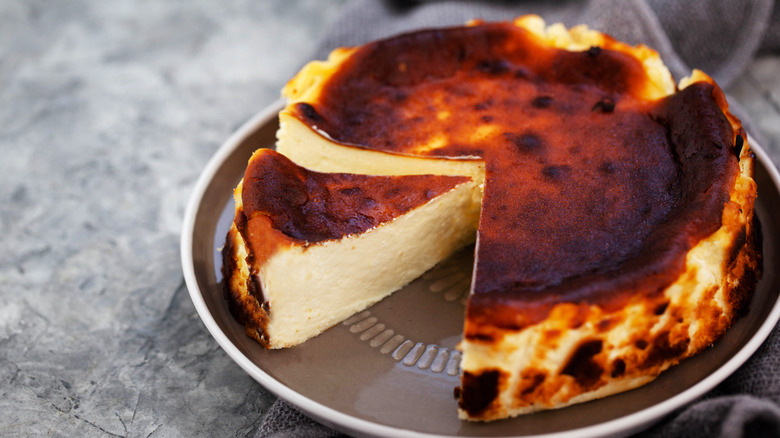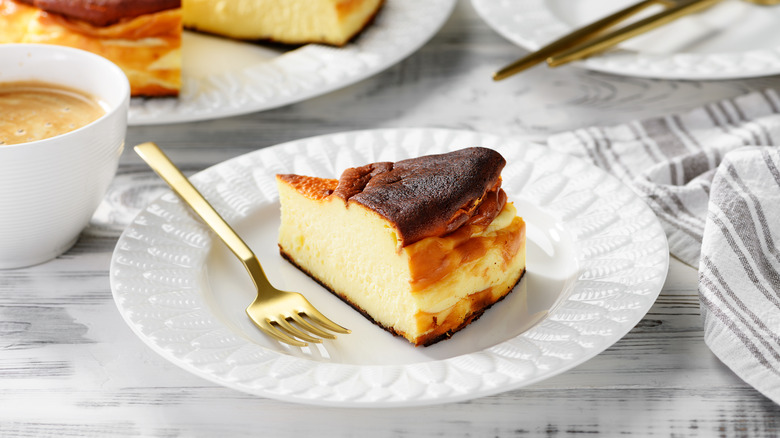What Makes Basque Cheesecake Different From The Classic Version?
While a simple look at a Basque cheesecake will show that it's different from the New York version, we wanted to dive even deeper. To do so, Food Republic chatted with Audrey Santos, Executive Sous Chef and head pastry chef at Maricel's Kitchen, to learn more about what makes it so unique. "While New York cheesecake is dense, rich, and ultra-smooth, Basque cheesecake is lighter, almost soufflé-like in the center, with a custardy texture that wobbles when you cut into it," Santos said.
And that's not all. While the iconic New York-style you've likely seen photos of requires "a crust, water bath, and a silky, even bake," Santos noted that a Basque cheesecake is created by simply pouring batter into a scrunched-up parchment paper-lined pan, and allowing a scorching-hot oven to caramelize the top. "That dark, nearly burnt surface is the signature look and flavor — it brings bitterness and depth that balances the creamy, custardy interior." Thanks to the parchment paper, this cheesecake is also much more rustic in appearance than its NYC cousin, with rough edges and a cracked exterior. While the way they're baked is different, so are the ingredients. Basque cheesecake only needs a handful of ingredients (like cream cheese, eggs, sugar, cream, and flour) and no additions (although some recipes use honey), while the New York version is known to be prepared with some alterations, like toppings. "It's a more rustic, dramatic dessert compared to the refined uniformity of a classic cheesecake," Santos said.
A closer look at Basque cheesecake
While cheesecake dates back to ancient Greece, the Basque cheesecake is much more recent. It was invented in the late 1950s at a family restaurant named La Viña in San Sebastián, Spain. It was created as a fun way to put a flan-esque spin on a classic cheesecake. With the growth of social media and food tours in the 2000s, the Basque cheesecake started to become popular. And with good reason. Aside from its unique appearance, Santos mentioned that you also get layers of flavor with every bite, including bittersweet caramel, tangy cream cheese, and a luxurious and creamy sweetness at the center.
If making it at home, she suggests using plenty of scrunched-up parchment paper — not only to give some overhang for easy removal, but also to give it its signature cracked sides. She also recommends cooking it at a high temperature of around 400-450 degrees Fahrenheit, and while you're looking for the exterior to be very dark, you don't want to wait for the center to be completely cooked in the oven. "Pull it out while the center still trembles when you shake the pan; it will continue to set as it cools." She went on to say that the beauty of this type of cheesecake is that it's meant to be forgiving, leaving you plenty of room to learn as you go. "It's one of those bakes where the less 'perfect' it looks, the more authentic it is."
A closer look at New York-style cheesecake
New York cheesecake (which is not technically a cake or a pie) is credited to have emerged in the 1920s thanks to Arnold Reuben, the owner of Reuben's Restaurant and Delicatessen and The Turf Restaurant in New York City. While similar to a classic cheesecake, it's noted for being much denser, relying on incorporating more cream and egg yolks to give it a heavier, ultra-luscious feel. One of the most famous New York cheesecakes was born in 1950, when Junior's in Brooklyn debuted its iconic dessert after countless recipe attempts. The one it ended up landing on is the one the restaurant still uses today.
The beauty of the New York-style cheesecake is not only in its smooth and creamy filling that relies on a good amount of cream cheese (although Alton Brown also includes sour cream for a velvety texture), but it's also known for its iconic graham cracker crust. Buttery and crunchy, this crust is the perfect addition to a hefty slice of cheesecake, lending some much-needed texture to an otherwise one-dimensional dessert. While available plain, you may also see a New York cheesecake topped with additional ingredients, like strawberry sauce, caramel, or fudge.



